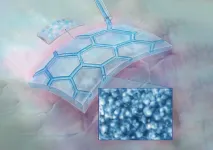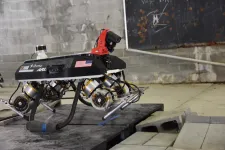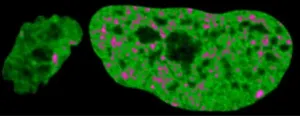INFORMATION:
Broadly neutralizing antibodies against pandemic flu point to new vaccine targets
2021-06-02
(Press-News.org) A new study reveals that B cells can produce antibodies against the H1N1 influenza virus that also neutralize various other influenza strains, marking a development that could inform research into potential universal flu vaccines. The findings showed that the antibodies targeted two conserved regions of the virus - the cause of the 2009 swine flu pandemic - and that transfers of the antibodies protected mice from lethal infection. The work suggests that vaccines that target the two sites might be able to protect against a broader array of flu strains. Influenza is one of humanity's greatest microbial foes, being responsible for both seasonal flu and more severe flu pandemics that pose major threats to global health. Current vaccines for seasonal flu induce antibodies against the "head" region of hemagglutinin, the major surface antigen on influenza viruses. However, this strategy only protects against a few strains of influenza, and these antigen sites mutate frequently enough that a new vaccine is needed each year. Searching for better vaccine targets, Jenna Guthmiller and colleagues studied the properties of antibodies from memory B cells exposed to the 2009 pandemic H1N1 influenza virus. They saw that the B cells produced antibodies that targeted the receptor-binding site or lateral patch epitopes, two regions of the hemagglutinin head that are conserved across many strains of influenza. As a result, these antibodies neutralized most H1 influenza viruses the researchers tested, and antibodies against the lateral patch also reacted to the H3N2 strain and to influenza B viruses. Furthermore, transfers of the antibodies protected mice from lethal doses of H1N1 influenza, and some of the lateral patch antibodies also neutralized a natural, recent flu strain with mutations in a major antigen site.
ELSE PRESS RELEASES FROM THIS DATE:
Pacific Northwest National Laboratory's shadow figment technology foils cyberattacks
2021-06-02
RICHLAND, Wash.--Scientists have created a cybersecurity technology called Shadow Figment that is designed to lure hackers into an artificial world, then stop them from doing damage by feeding them illusory tidbits of success.
The aim is to sequester bad actors by captivating them with an attractive--but imaginary--world.
The technology is aimed at protecting physical targets--infrastructure such as buildings, the electric grid, water and sewage systems, and even pipelines. The technology was developed by scientists at the U.S. Department of Energy's Pacific Northwest National Laboratory.
The starting point for Shadow Figment is an oft-deployed technology called a honeypot--something attractive to lure an attacker, perhaps a desirable target with the appearance of easy access.
But ...
Study offers insights for communicating about wildlife, zoonotic disease amid COVID-19
2021-06-02
A new study from North Carolina State University found that certain types of messages could influence how people perceive information about the spread of diseases from wildlife to humans.
The researchers say the findings, published in the journal Frontiers in Communication, could help scientists, policymakers and others more effectively communicate with diverse audiences about zoonotic diseases and the role of wildlife management in preventing them from spreading to people. Zoonotic diseases are diseases that originate in wildlife and become infectious to people.
"If we want to prevent ...
Opioid Agonist Therapy reduces mortality risk among people with opioid dependence
2021-06-02
A new global review has found that receiving Opioid Agonist Therapy (OAT) is associated with lower risk of multiple causes of death among people with opioid dependence.
The review found that people with opioid dependence were less likely to experience overdose-related, suicide, alcohol-related, cancer, and cardiovascular-related mortality while receiving OAT.
Researchers from the National Drug and Alcohol Research Centre (NDARC) at UNSW Sydney, University of Bristol and several other global institutions reviewed the relationship between OAT and mortality across type of drug, setting and participant groups from over 700,000 participants, which is six times the number of any other previous review.
The review found that mortality risk ...
Spiders can sniff out and avoid killer ants, SFU study finds
2021-06-02
Spiders avoid building webs near European fire ants, their natural predators, by sensing the chemicals they give off in the environment, Simon Fraser University researchers have found.
The findings, published recently in Royal Society Open Science, give us a peek inside the enduring struggle between spiders and ants, and could lead to the development of natural repellents for homeowners worried about unwanted eight-legged guests.
Many ants prey on spiders, suggesting that web-building spiders may avoid locations near ant colonies or frequented by foraging ...
Printing a better microgrid
2021-06-02
The future of electronic displays will be thin, flexible and durable. One barrier to this, however, is that one of the most widely used transparent conductors for electronic displays--indium tin oxide (ITO)--doesn't perform as well on larger areas and can crack and break down with wear. Indium is also a rare earth mineral, which is relatively scarce, and the process to create ITO requires high energy consumption and expensive equipment.
One emerging alternative is metal "microgrid" conductors. These microgrids can be customized to their application by varying the microgrid width, pitch and thickness, and they can be made with a variety of metals.
New research from the University of Pittsburgh Swanson School of Engineering ...
The powerhouse future is flexoelectric
2021-06-02
Researchers have demonstrated "giant flexoelectricity" in soft elastomers that could improve robot movement range and make self-powered pacemakers a real possibility. In a paper published this month in the Proceedings of the National Academy of Sciences, scientists from the University of Houston and Air Force Research Laboratory explain how to engineer ostensibly ordinary substances like silicone rubber into an electric powerhouse.
What do the following have in common: a self-powered implanted medical device, a soft human-like robot and how we hear sound? The answer as to why these two disparate technologies and biological phenomena ...
The uneven benefits of CSR efforts
2021-06-02
SMU Office of Research & Tech Transfer - Whether they are in the technology or oil sector, selling shoes or healthcare products, for many companies, green is the new black. While maximising profit might have been the sole priority for most businesses a decade ago, these days it is common for mission-oriented companies to pursue the 'triple bottom line' of people, planet and profit, particularly through corporate social responsibility (CSR) efforts.
While such efforts are commendable, some investors remain primarily concerned about whether firms can do well by doing good; in other words, whether CSR actually can increase a company's value. For instance, CSR activities could enhance brand image and improve customer loyalty, or even make it easier to attract and retain talent, leading to ...
Similarity of legs, wheels, tracks suggests target for energy-efficient robots
2021-06-02
ABERDEEN PROVING GROUND, Md. - A new formula from Army scientists is leading to new insights on how to build an energy-efficient legged teammate for dismounted warfighters.
In a recent peer-reviewed PLOS One paper, the U.S. Army Combat Capabilities Development Command, known as DEVCOM, Army Research Laboratory's Drs. Alexander Kott, Sean Gart and Jason Pusey offer new insights on building autonomous military robotic legged platforms to operate as efficiently as any other ground mobile systems.
Its use could lead to potentially important changes to Army vehicle development. Scientists said they may not know exactly why legged, wheeled and tracked ...
Major advance in fabrication of low-cost solar cells also locks up greenhouse gases
2021-06-02
BROOKLYN, New York, Wednesday, June 2, 2021 - Perovskite solar cells have progressed in recent years with rapid increases in power conversion efficiency (from 3% in 2006 to 25.5% today), making them more competitive with silicon-based photovoltaic cells. However, a number of challenges remain before they can become a competitive commercial technology.
Now a team at the END ...
How is the genome like an open book? New research shows cells' 'library system'
2021-06-02
The organization of the human genome relies on physics of different states of matter - such as liquid and solid - a team of scientists has discovered. The findings, which reveal how the physical nature of the genome changes as cells transform to serve specific functions, point to new ways to potentially better understand disease and to create improved therapies for cancer and genetic disorders.
The genome is the library of genetic information essential for life. Each cell contains the entire library, yet it uses only part of this information. Special types of cells, such ...




